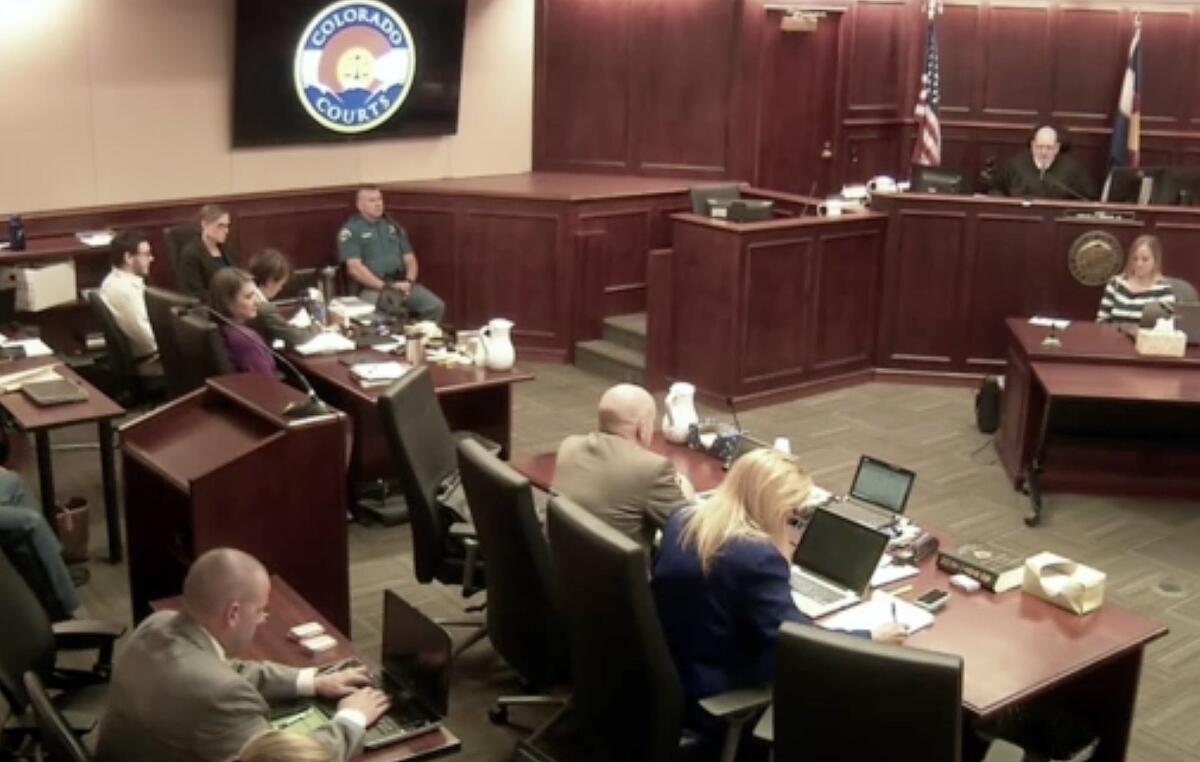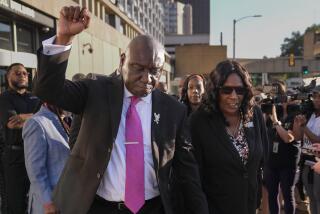James Holmes jury finds aggravating factors exist, moves on to second phase

Colorado theater shooter James Holmes, top left in light-colored shirt, sits in Arapahoe County District Court, where his trial continues Thursday in Centennial, Colo.
- Share via
The same jury that found James Holmes guilty of murdering a dozen people during a midnight screening of “The Dark Knight Rises” in Aurora, Colo., ruled Thursday that he acted in an especially cruel manner when he blasted his way through the multiplex.
Jurors, who also found that Holmes lay in wait and ambushed his victims, decided that the gunman did not go to the crowded theater intending to kill children -- one of the five aggravating factors that could lead to a death penalty.
Over and over in the quiet courtroom, Judge Carlos A. Samour Jr. intoned the jury’s verdicts as he named each of the 12 people Holmes murdered three years ago:
“We the jury do unanimously find that the prosecution has proven beyond a reasonable doubt the existence of at least one of the alleged aggravating factors with respect to this count of murder in the first degree,” Samour said.
“Part B reflects that the jury has found that all four of the aggravating factors alleged by the prosecution with respect to this count have been proven by the prosecution beyond a reasonable doubt.”
Holmes was convicted on July 16 of 165 counts, including first-degree murder and attempted murder, in the July 20, 2012, theater rampage.
The sentencing phase of the trial began Wednesday, with prosecutors arguing that Holmes should be found guilty of five aggravating factors when he murdered eight men, three women and a girl who had just finished kindergarten.
SIGN UP for the free Today’s Headlines newsletter >>
The factors were that he killed more than two people, that he intentionally killed a child younger than 12, that he knowingly created a “grave risk of death” for others beyond the people he killed, that he acted in an especially heinous, cruel or depraved manner and that he lay in wait and ambushed his victims.
After less than a full day of deliberation, the jurors agreed that he was guilty of four of those circumstances.
Neither the defense nor the prosecution introduced any new evidence in the aggravating-factor phase of sentencing, and the defense did not offer a closing argument.
In his closing, prosecuting attorney Richard Orman was fast, passionate and to the point.
He paid particular attention to the question of whether Holmes killed a child intentionally -- the one aggravating factor that the jury said the gunman did not commit.
During the trial itself, jurors saw 22 hours of recorded video interviews, during which the gunman told a court-appointed psychiatrist that he did not want to kill children.
“I tried to minimize child fatalities. I chose the night showing,” he said in the video. “It was sad that a child had died. I don’t know how it could have been avoided though, other than changing the plan into something else.... It wasn’t my intention to kill children or leave them parentless or that stuff.”
But as Holmes sprayed the Century 16 multiplex with gunfire, Veronica Moser-Sullivan, 6, was killed, and the packed theater was filled with other children, including a baby in the same row as the shooter.
“The evidence shows you that the defendant had the conscious objective to kill everyone in the theater, man, woman and child alike,” Orman told the jurors. “He went in there with three weapons: the handgun, the AR-15, the shotgun. He went in there with enough firepower and enough ammunition to kill everybody.
“How do we know he intended to kill a child?” he asked. “Go back all the way to April 28. You heard from a witness named Chichi Spruel. She told you that the theater was packed with kids.... The defendant had the intent to kill every single one of them.”
But the jury did not agree, apparently swayed by Holmes’ protests that children were not his intended targets.
As soon as the first part of the penalty phase was over, the second part began, with defense attorneys presenting evidence of mitigating factors. The Thursday afternoon session included several of Holmes’ high school teachers.
During this mitigation phase, the defense is expected to try to humanize Holmes and paint the picture of a deeply mentally ill man who deserves mercy. His parents are set to testify along with teachers, friends and others who knew him before the attack.
If jurors agree there are mitigating factors, then a third part of the sentencing phase begins, with jurors weighing the aggravating factors against the mitigating ones to decide if Holmes should live or die.
During each part of the penalty phase, both sides may provide additional evidence and give opening statements and closing arguments.
Follow @marialaganga for national news.
ALSO
Shell receives final approval to drill in Arctic, but with new conditions
Sandra Bland’s autopsy shows no sign of violent homicide, prosecutor says
Family of 5 found dead in Oklahoma; 2 teens believed to be oldest sons are arrested
More to Read
Sign up for Essential California
The most important California stories and recommendations in your inbox every morning.
You may occasionally receive promotional content from the Los Angeles Times.











